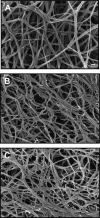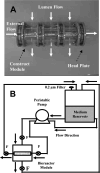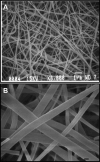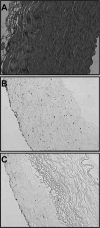Review: advances in vascular tissue engineering using protein-based biomaterials
- PMID: 17961004
- PMCID: PMC2257983
- DOI: 10.1089/ten.2007.0196
Review: advances in vascular tissue engineering using protein-based biomaterials
Abstract
The clinical need for improved blood vessel substitutes, especially in small-diameter applications, drives the field of vascular tissue engineering. The blood vessel has a well-characterized structure and function, but it is a complex tissue, and it has proven difficult to create engineered tissues that are suitable for widespread clinical use. This review is focused on approaches to vascular tissue engineering that use proteins as the primary matrix or "scaffold" material for creating fully biological blood vessel replacements. In particular, this review covers four main approaches to vascular tissue engineering: 1) cell-populated protein hydrogels, 2) cross-linked protein scaffolds, 3) decellularized native tissues, and 4) self-assembled scaffolds. Recent advances in each of these areas are discussed, along with advantages of and drawbacks to these approaches. The first fully biological engineered blood vessels have entered clinical trials, but important challenges remain before engineered vascular tissues will have a wide clinical effect. Cell sourcing and recapitulating the biological and mechanical function of the native blood vessel continue to be important outstanding hurdles. In addition, the path to commercialization for such tissues must be better defined. Continued progress in several complementary approaches to vascular tissue engineering is necessary before blood vessel substitutes can achieve their full potential in improving patient care.
Figures








Similar articles
-
Development of small tissue engineered blood vessels and their clinical and research applications.Biofabrication. 2025 May 27;17(3). doi: 10.1088/1758-5090/add626. Biofabrication. 2025. PMID: 40341214 Review.
-
Fibrin: a natural biodegradable scaffold in vascular tissue engineering.Cells Tissues Organs. 2008;188(4):333-46. doi: 10.1159/000139772. Epub 2008 Jun 13. Cells Tissues Organs. 2008. PMID: 18552484 Review.
-
Engineering blood vessels and vascularized tissues: technology trends and potential clinical applications.Clin Sci (Lond). 2019 May 14;133(9):1115-1135. doi: 10.1042/CS20180155. Print 2019 May 15. Clin Sci (Lond). 2019. PMID: 31088895 Review.
-
Electrochemical fabrication of a biomimetic elastin-containing bi-layered scaffold for vascular tissue engineering.Biofabrication. 2018 Nov 9;11(1):015007. doi: 10.1088/1758-5090/aaeab0. Biofabrication. 2018. PMID: 30411718
-
Biomaterials for vascular tissue engineering.Regen Med. 2010 Jan;5(1):107-20. doi: 10.2217/rme.09.77. Regen Med. 2010. PMID: 20017698 Free PMC article. Review.
Cited by
-
Secreted Endothelial Cell Factors Immobilized on Collagen Scaffolds Enhance the Recipient Endothelial Cell Environment.Biores Open Access. 2016 Mar 1;5(1):61-71. doi: 10.1089/biores.2016.0003. eCollection 2016. Biores Open Access. 2016. PMID: 27057474 Free PMC article.
-
3D bioprinting for modelling vasculature.Microphysiol Syst. 2018 Nov;2:9. doi: 10.21037/mps.2018.10.02. Epub 2018 Nov 5. Microphysiol Syst. 2018. PMID: 30931432 Free PMC article.
-
The attenuation of platelet and monocyte activation in a rabbit model of extracorporeal circulation by a nitric oxide releasing polymer.Biomaterials. 2010 Apr;31(10):2736-45. doi: 10.1016/j.biomaterials.2009.12.028. Epub 2009 Dec 29. Biomaterials. 2010. PMID: 20042236 Free PMC article.
-
Sequential assembly of cell-laden hydrogel constructs to engineer vascular-like microchannels.Biotechnol Bioeng. 2011 Jul;108(7):1693-703. doi: 10.1002/bit.23102. Epub 2011 Mar 11. Biotechnol Bioeng. 2011. PMID: 21337336 Free PMC article.
-
Acellular vascular grafts generated from collagen and elastin analogs.Acta Biomater. 2013 Sep;9(9):8067-74. doi: 10.1016/j.actbio.2013.05.024. Epub 2013 Jun 3. Acta Biomater. 2013. PMID: 23743129 Free PMC article.
References
-
- Atala A, Bauer SB, Soker S, Yoo JJ, Retik AB. Tissue-engineered autologous bladders for patients needing cystoplasty. Lancet. 2006;367:1241. - PubMed
-
- Shin'oka T, Matsumura G, Hibino N, Naito Y, Watanabe M, Konuma T, Sakamoto T, Nagatsu M, Kurosawa H. Midterm clinical result of tissue-engineering vascular autografts seeded with autologous bone marrow cells. J Thorac Cardiovasc Surg. 2005;129:1330. - PubMed
-
- Rosamond W, Flegal K, Friday G, Furie K, Go A, Greenlund K, Haase N, Ho M, Howard V, Kissela B, Kittner S, Lloyd-Jones D, McDermott M, Meigs J, Moy C, Nichol G, O'Donnell CJ, Roger V, Rumsfeld J, Sorlie P, Steinberger J, Thom T, Wasserthiel-Smoller S, Hong Y American Heart Association Statistics Committee and Stroke Statistics Subcommittee. Heart disease and stroke statistics—2007 update: a report from the American Heart Association Statistics Committee and Stroke Statistics Subcommittee. Circulation. 2007;115:e69. - PubMed
-
- Williams SK. Endothelial cell transplantation. Cell Transplant. 1995;4:401. - PubMed
-
- Zilla P, Deutsch M, Meinhart J. Endothelial cell transplantation. Semin Vasc Surg. 1999;12:52. - PubMed
Publication types
MeSH terms
Substances
Grants and funding
LinkOut - more resources
Full Text Sources
Other Literature Sources

